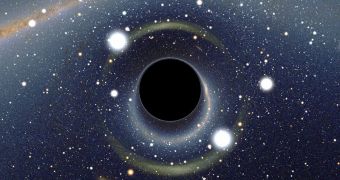Two new research papers recently published in the online journal arXiv provide additional corroboration for a theory that suggests the Universe is just a hologram, a 3D projection of a 2D space.
This idea was first formulated by theoretical physicist Juan Maldacena back in 1997. Interestingly, the new studies provide a ten-dimensional (10D) theory of gravity that somehow reach the same conclusion as standard thinking in quantum mechanics does.
Maldacena's original theory proposed that widely accepted physics could be used to interpret a Universe where gravity is generated by thin, vibrating strings, the so-called string theory. This theory requires nine dimensions (plus time) to make sense.
By reinterpreting it, the theoretical physicist was able to show that the Universe may in fact be flat, and feature no gravity at all. This would naturally imply that the Cosmos is a hologram, or a large-scale projection that is unsubstantiated in reality.
In addition to solving some inconsistencies that exist between quantum mechanics and the theory of gravity, this idea also provided additional support for string theory. Furthermore, physicists have been using it to translate problems from Newtonian physics to quantum mechanics, and vice—versa, ever since.
Even though most of the scientific community takes Maldacena's theory for granted, few pieces of evidence were even produced to demonstrate it. This is where the two new papers, by Ibaraki University investigator Yoshifumi Hyakutake and his team, come in, Nature reports.
The first paper is centered around calculating measurements related to the internal energy levels of black holes. Hyakutake focuses on establishing the position of event horizons, on determining entropies inside black holes, and on quantifying other properties suggested by string theory.
The second paper deals with calculations related to the internal energy of a potential 2D Cosmos that features no gravitation. According to the two studies, the calculations match, and provide the solidest evidences for the hologram Universe theory to date.
“It seems to be a correct computation. [The new findings] are an interesting way to test many ideas in quantum gravity and string theory,” comments Maldacena, who was not a part of the study. He now holds an appointment with the Institute for Advanced Study in Princeton, New Jersey.
“They have numerically confirmed, perhaps for the first time, something we were fairly sure had to be true, but was still a conjecture – namely that the thermodynamics of certain black holes can be reproduced from a lower-dimensional Universe,” concludes Stanford University theoretical physicist Leonard Susskind, one of the first theoreticians ever to look into the hologram Cosmos idea.

 14 DAY TRIAL //
14 DAY TRIAL //